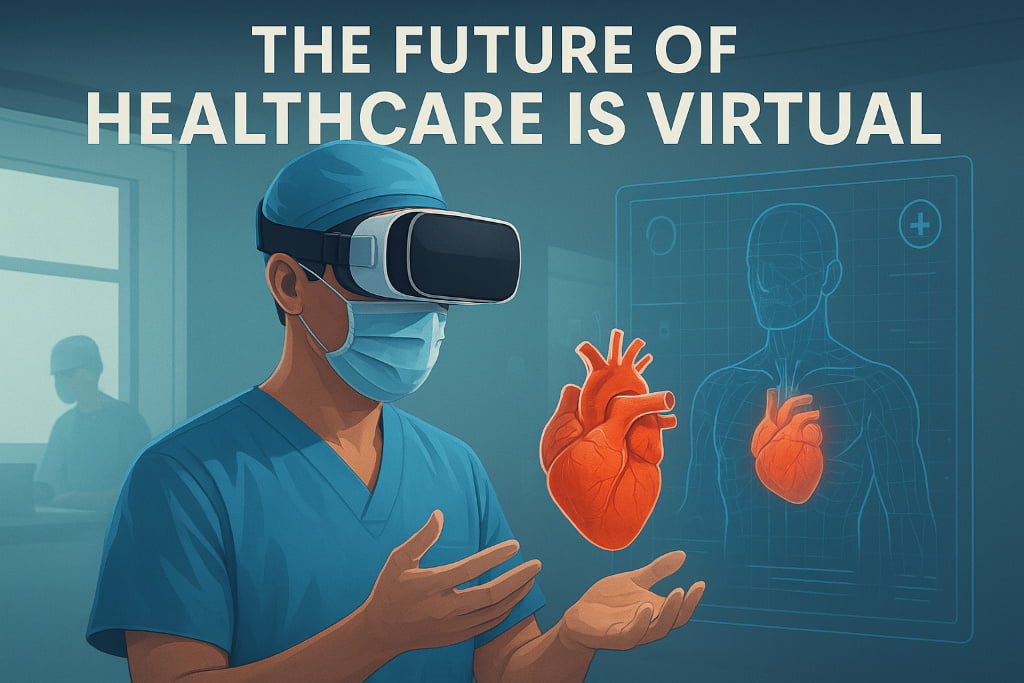In a world where technology is redefining every aspect of life, one industry stands at the edge of a digital revolution — Healthcare. Imagine doctors performing surgeries without touching the patient, medical students practicing complex procedures in virtual labs, or patients overcoming trauma through immersive therapy — this isn’t science fiction anymore. This is the power of AR (Augmented Reality) and VR (Virtual Reality) transforming the way we heal, learn, and live.
Welcome to the future of healthcare — a future that’s virtual, intelligent, and life-saving.
What Is AR / VR in Healthcare?
Before we dive deeper, let’s break it down simply:
- Augmented Reality (AR) overlays digital information — like 3D anatomy models or visual guides — onto the real world.
- Virtual Reality (VR) creates a completely immersive, simulated environment where users can interact with digital objects as if they’re real.
Together, AR and VR are reshaping how doctors diagnose, treat, and train, creating a bridge between human expertise and digital precision.
Virtual Reality in Surgery: Precision Beyond Imagination
Picture this — a surgeon wearing VR goggles, navigating a 3D replica of the patient’s body before the actual operation. Every vein, artery, and organ can be visualized in detail.
With VR-powered simulations, doctors can practice high-risk surgeries multiple times before performing them, reducing errors and improving confidence.
According to recent studies, VR-based surgical training can increase accuracy by over 40% compared to traditional methods. For complex surgeries like brain or cardiac procedures, that precision can literally mean the difference between life and death.
Isn’t it fascinating that the world’s most skilled surgeons are now training in virtual environments — long before entering the operating room?
AR: The Doctor’s New Superpower
While VR creates a new world, AR enhances the real one.
Surgeons now use AR headsets like Microsoft HoloLens to project 3D organ models directly onto the patient during surgery. This means doctors can “see” inside the body without making large incisions.
Even during routine checkups, AR apps help visualize internal structures, making diagnosis faster and more accurate.
From remote consultations to AR-guided rehabilitation exercises, this technology is bringing healthcare to people’s homes, breaking the barriers of location and access.
Virtual Therapy: Healing the Mind, Not Just the Body
Here’s where things get even more interesting.
VR isn’t just about surgery — it’s becoming a powerful tool for mental health treatment.
Patients suffering from PTSD, anxiety, and chronic pain can use VR environments to relive and reprogram traumatic memories safely.
For instance, a soldier battling PTSD can be virtually exposed to stressful scenarios in a controlled environment — gradually reducing fear and anxiety.
Similarly, burn victims or chronic pain patients can immerse themselves in calming, snowy VR landscapes during painful treatments — diverting their mind and reducing pain perception.
In short, virtual reality is healing where medicine alone cannot reach.
Training the Next Generation of Medical Heroes
Medical education has always been one of the toughest journeys — but AR / VR is changing that too.
Instead of reading anatomy from textbooks, students can now walk through a 3D human body in VR, interacting with organs, veins, and tissues in real-time.
Complex procedures like heart transplants or tumor removals can be simulated again and again, helping students gain real-world experience without any real-world risk.
This means future doctors will be better trained, more confident, and more skilled — all thanks to immersive AR / VR training systems.
The Global Impact: Healthcare Without Borders
One of the most exciting benefits of AR / VR in healthcare is remote accessibility.
Through virtual consultations, a patient in a remote village can connect with a top surgeon miles away.
Even complex operations can be guided remotely using AR-assisted visuals.
This technology is bridging the healthcare gap between urban and rural areas, ensuring that expert care is no longer limited by geography.
In the future, a virtual hospital could treat patients worldwide — without walls, without borders.
Challenges and the Road Ahead
Of course, every revolution comes with challenges.
The cost of AR / VR equipment, lack of standardization, and the need for advanced hardware are still hurdles to overcome.
But as technology becomes more affordable and widespread, we’re heading toward a time when every hospital, clinic, and medical school will integrate AR / VR solutions.
The question isn’t if this will happen — it’s how soon.
The Future Is Already Here
We’ve reached a point where healthcare and technology are inseparable. AR and VR are no longer futuristic dreams — they’re life-saving realities being implemented across the globe.
From virtual surgeries to AI-powered diagnostics, from VR therapy to remote care, these technologies are shaping a healthier, smarter, and more connected world.
So, the next time you hear the word “virtual,” remember — it might just be the reason someone gets a second chance at life.
We Are Experts in AR / VR Development
At Atina Technology, we don’t just follow trends — we build the future.
Our team specializes in AR / VR development for healthcare, education, real estate, and more.
If you’re ready to bring your ideas to life through immersive technology, connect with us today and let’s create something extraordinary together.


